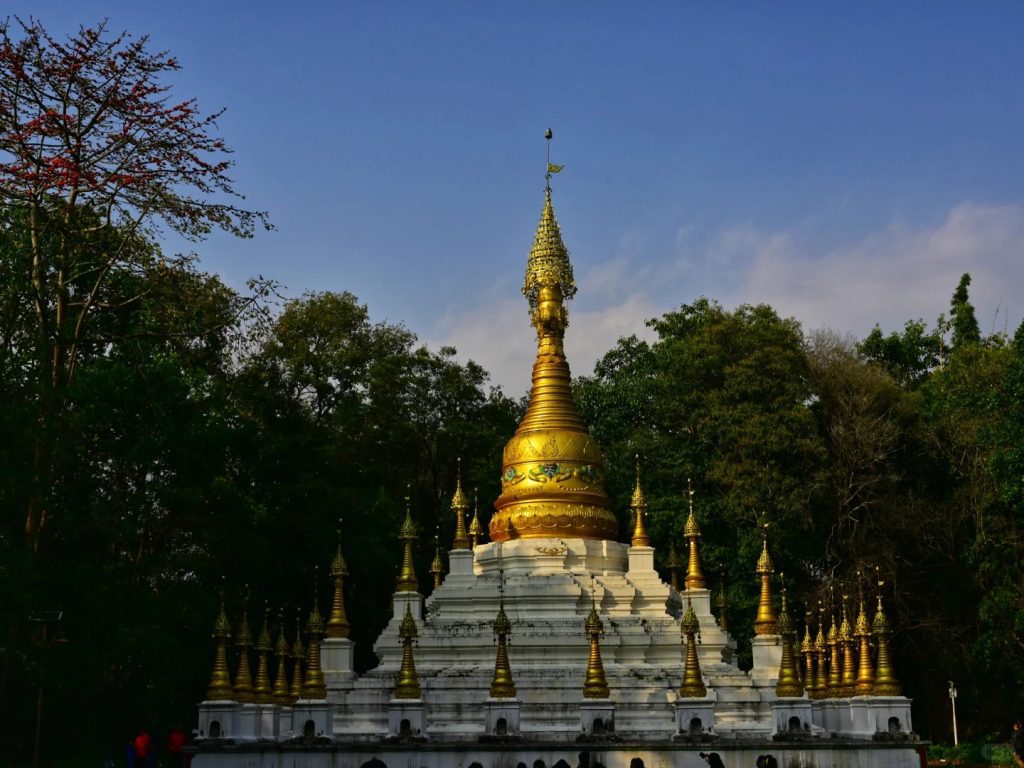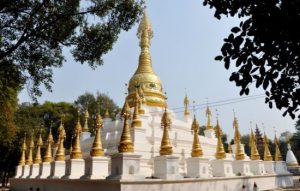Yunyan Stupa in Yingjiang County, Dehong

Attractions Overview
Yunyan Stupa in Yingjiang County, also known as Manmengding Stupa, is located on the top of Yunyan Mountain, 1 km east of Yingjiang County. “Yunyan” in Dai Language means an auspicious, joyful and fascinating place. It is one of the most important Buddhist pagodas of Hinayana in Yunnan. The pagoda was built in 1947 and it took eight years to complete the work. Although it is a modern product, it is rich in ancient style and is listed as a key cultural relic protection unit in Yunnan Province.
Chinese Name: 盈江允燕佛塔(Pinyin: Yingjiang Yunyang Fota)
English Name: Yunyan Stupa in Yingjiang County, Dehong
Attraction Type: Buddhism Holy, Pagoda
Best Time to Visit: All year round
Recommended Visiting Time: 3 hours
Opening Hours: All day long
Admission Fee: Free
Address: The top of Yunyan Mountain, 1 km east of Yingjiang County(盈江县城以东1公里的允燕山上)
📍 Location & Best Season
Coordinates: 1.5 km east of Yingjiang County, Dehong Dai & Jingpo Autonomous Prefecture, Yunnan (云南省德宏傣族景颇族自治州盈江县城东1.5 km)
Altitude: 857 m
Landscape: At the foothills of Gaoligong Mountains’ end, overlooking the “S”-shaped Daying River valley and万亩 bamboo-rice fields.
Best Time to Visit:
– Oct–Mar: Dry season ☀️, clear skies, high chance of sunrise sea-of-clouds.
– Munao Zongge Festival (正月十五目瑙纵歌节) & Water Splashing Festival (泼水节): Experience two epic ethnic celebrations! 🎉
✈️ Getting There
| From | Route | Duration | Cost | Tips |
|---|---|---|---|---|
| Kunming | Flight → Mangshi Airport → Bus to Yingjiang | 3.5h | Flight ¥400+ & Bus ¥60 | Taxi to Mangshi bus station: 15min 🚖 |
| Kunming | Flight → Tengchong Airport → Carpool | 3h | Flight ¥350+ & Carpool ¥80 | Find rides at airport exit 🚌 |
| Kunming | Overnight Bus (West Bus Station) | 9h | ¥242 | Departs 18:00-21:00, arrives at dawn 🌙 |
| Yingjiang Town | Taxi/Walk via Mengla Road | 10min | ¥10 | Follow “允燕塔/Yunyan Pagoda” signs 🚶♂️ |
🌟 Architectural Highlights (1.5h Loop)
1️⃣ Vajrasana Pagoda Complex
– 1 main pagoda (24.9m) + 40 sub-pagodas symbolizing the Buddhist cosmos.
– Five-tiered octagonal base with golden spire crowned by a sacred umbrella ☂️. Wind chimes sing with the breeze!
– 7 guardian reliefs (tiger/lion/elephant/rat/goat/dragon/eagle) holding 108 Buddhist beads – carved by Sino-Myanmese artisans.
2️⃣ Mythical “Gaduo” Guardians
– Twin Burmese-style chimeras at the stairway – perfect photo foreground 📸.
3️⃣ Cultural Plaza
– North: Munao ritual pillar (目瑙示栋) for Jingpo ethnic dances.
– South: Buddha-bathing stupa (浴佛塔) – Water Festival’s core site 💦.
🎯 Half-Day Itinerary
- 09:00: Town breakfast (Dai rice noodles + lemon beef 🍜)
- 09:30: Climb stairs, admire pagodas, drone photography 🚁
- 10:30: Munao pillar photo + learn Jingpo sun motifs ☀️
- 11:00: Banyan tree shadows + pagoda reflections (misty in monsoon!)
- 12:00: Vegetarian lunch at Bodhi Temple / Dai hand-tossed rice in town
- 14:00: Optional: Daying River bamboo rafting or Phoenix Mountain rubber forest cycling 🚣♂️
📅 Festivals
- Munao Zongge Festival (Jan/Feb): 3 days of 10,000-strong drum dances 🥁
- Water Splashing Festival (Mid-Apr): Buddha bathing, bazaars, sky lanterns 🪔
- Pagoda Offering Festival (Oct): Sand stupa building & monk almsgiving 🙏
ℹ️ Visitor Info
- Admission: FREE (exterior accessible; interior closed)
- Guides: ¥5 audio scan or book Dai elders at Yunyan Community 🧓
- Parking: 50 spots at base – arrive before 8:30 during festivals!
🍽️ Stay & Savor
Accommodation:
– Budget: Yingjiang Hotel (¥120+, 10min walk)
– Luxury: Kai Hotel at Kaibangya Lake (¥380+, 25min drive 🏞️)
Food:
– Dai Cuisine: Pineapple sticky rice, lemongrass fish, Sai Pia (herb-infused rice noodles)
– Jingpo Flavors: “Ghost chicken” (舂鸡), fermented rice wine 🍚
Souvenirs: Myanmar jade Buddha pendants, handmade Dai paper lamps, Jingpo brocade 💎
❗ Pro Tips
- Photography: Best pagoda light 7:30-8:30 AM; sunset golden clouds 🌅
- Drones: Register free at county PSB (5min online) ⚠️
- Respect: Remove shoes on pagoda platform; never turn your back to Buddha 🙏
- Pack rain gear (monsoon); wear SPF50+ (intense UV!) ☔
✨ Why Visit?
At Yunyan Pagoda (允燕佛塔), behold misty river valleys in 10 minutes, hear 40 wind chimes in 10 seconds, and immerse in Dai & Jingpo festivals in 1 day – Yunnan’s ultimate “Paukphaw” (胞波) cultural landmark! 🇨🇳🤝🇲🇲
Nearby Attractions
XiangEhu Lake
Located in the southwest of Jiucheng Town of Yingjiang County, the beautiful XiangEhu Lake is the gateway and business card of Jiucheng Town. There are natural wetlands, sparkling natural lakes, and thousands of acres of lotus ponds with unique charm. XiangEhu Lake has a large amount of water, is not dry all year round, has good water quality, and contains many trace elements needed by the human body. There are more than ten kinds of wild fish in the lake, as well as birds such as egrets, yellow ducks and wild ducks, as well as aquatic plants such as lotus, reed and water hyacinth.

 7 Days GolfingTour
7 Days GolfingTour
 8 Days Group Tour
8 Days Group Tour
 8 Days Yunnan Tour
8 Days Yunnan Tour
 7 Days Shangri La Hiking
7 Days Shangri La Hiking
 11 Days Yunnan Tour
11 Days Yunnan Tour
 6 Days Yuanyang Terraces
6 Days Yuanyang Terraces
 11 Days Yunnan Tour
11 Days Yunnan Tour
 8 Days South Yunnan
8 Days South Yunnan
 7 Days Tea Tour
7 Days Tea Tour
 8 Days Muslim Tour
8 Days Muslim Tour
 12 Days Self-Driving
12 Days Self-Driving
 4 Days Haba Climbing
4 Days Haba Climbing
 Tiger Leaping Gorge
Tiger Leaping Gorge
 Stone Forest
Stone Forest
 Yunnan-Tibet
Yunnan-Tibet
 Hani Rice Terraces
Hani Rice Terraces
 Kunming
Kunming
 Lijiang
Lijiang
 Shangri-la
Shangri-la
 Dali
Dali
 XishuangBanna
XishuangBanna
 Honghe
Honghe
 Kunming
Kunming
 Lijiang
Lijiang
 Shangri-la
Shangri-la
 Yuanyang Rice Terraces
Yuanyang Rice Terraces
 Nujiang
Nujiang
 XishuangBanna
XishuangBanna
 Spring City Golf
Spring City Golf
 Snow Mountain Golf
Snow Mountain Golf
 Stone Mountain Golf
Stone Mountain Golf














